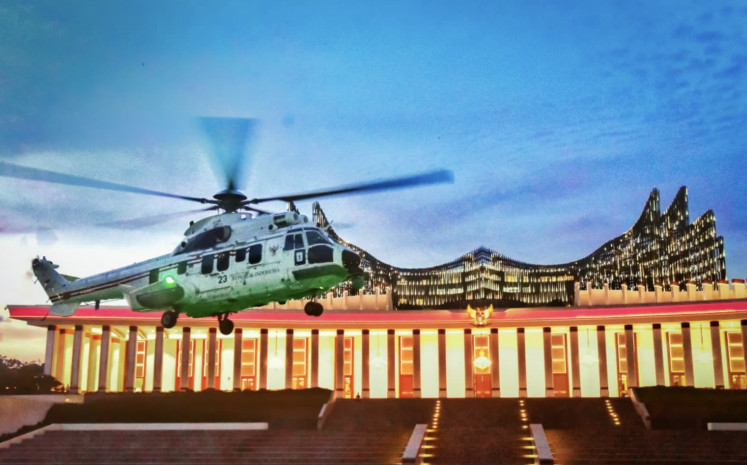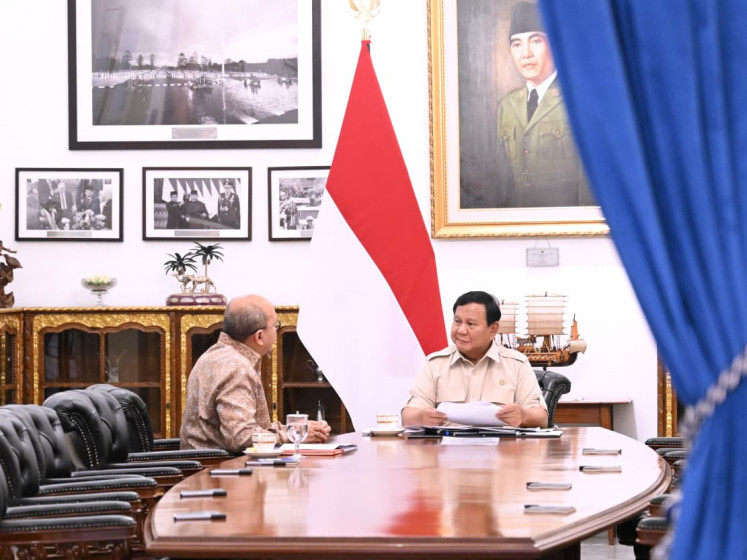Popular Reads
Top Results
Can't find what you're looking for?
View all search resultsPopular Reads
Top Results
Can't find what you're looking for?
View all search resultsGas-powered transportation: Why is it moving so slowly?
Why does Indonesia — a long-time gas-exporting country — not use gas to fuel its transportation system? Gas is cleaner, cheaper, and it burns more efficiently than gasoline/diesel fuels
Change text size
Gift Premium Articles
to Anyone
W
hy does Indonesia — a long-time gas-exporting country — not use gas to fuel its transportation system? Gas is cleaner, cheaper, and it burns more efficiently than gasoline/diesel fuels. While we are experiencing the severe oil-subsidy problem, why don’t we utilize our gas in vast amounts as a substitute for oil in our transportation?
The question is asked frequently when oil prices increase and the government is busy finding responses to the price hikes.
The use of gas to fuel transportation vehicles is practiced widely in Pakistan, India, Argentina, Brazil, Iran, Japan, South Korea, Singapore and Malaysia. Worldwide, there were 11.2 million natural gas vehicles (NGV) by 2009, led by Pakistan (2.4 million), Argentina (1.8 million), Iran (1.7 million), Brazil (1.6 million) and India (0.8 million). Pakistan, the world leader, is currently operating about 3,000 CNG (compressed natural gas) refueling stations.
Indonesia is already using gas for some transportation, actually. We started promoting CNG for public transportation in 1987. However, in contrast to NGV and CNG refueling stations that have been installed in Pakistan, India and many other countries, our operating CNG refueling stations currently only number about 10, while our vehicles running on CNG are less than 1,000.
There are two categories of gas used to fuel vehicles. The first most common is CNG, which is made by compressing natural gas (consists mostly of methane) to less than 1 percent of the volume it occupies at standard atmospheric pressure.
The other kind is liquefied gas, which could be based on either LPG (liquefied petroleum gas) or LNG (liquefied natural gas).
LPG cars (vehicles using LGV: liquefied gas for vehicles, which is based on LPG) are popular in India and can be found in Japan, Canada, Italy, the Netherlands and France. LNG vehicles are driven in LNG-importing countries such Japan and South Korea.
In Indonesia, CNG was endorsed by the government’s launching of the Blue Sky program in 1996. Following the endorsement, the total number of refueling stations reached 30 units in the Jakarta area, Medan, Palembang, Surabaya and Denpasar. Unfortunately, due to several factors, that number has been decreasing. Currently, the CNG (known locally as BBG) is utilized to fuel Jakarta’s bus fleet and a number of taxis.
LGV has also been introduced in recent years by Pertamina using Vigas as its trademark. Vigas is sold sparingly in Jakarta. So far, Indonesia has not brought in LNG as vehicle fuel.
While many other countries are promoting “gas for transport” (including by those having no gas reserves in their territories), the question becomes why a similar program is not working well in Indonesia?
The major reason is that pricing is not being set correctly.
When BBG/CNG was introduced, economic price was considered unimportant. The volume of gas delivered was small while the company was in a strong financial position.
In addition, the company promoting the program was playing additional roles as a regulator and a government representative. The BBG/CNG was priced at discount rates.
The situation is far different since the Law on Oil and Gas was issued in 2001, forcing the company to work with a profit motive. While other customers (industry, electricity) demand larger volume and offer better prices, the transport sector is still asking for “old, low” prices. Beyond all questions, this makes the gas company reluctant to produce and deliver/transport the gas.
One reason is the pricing factor. The government still keeps prices for gasoline and diesel oil low, reducing the incentives to shift to gas. This is in contrast with, for example India, which gives zero subsidy to gasoline but about 40 percent to gas to boost its use.
Another reason is that shifting to gas will require investing in converter kits. Even though gas is cheaper and in the long term promises lower costs, the kit’s high up-front cost hinders our existing gasoline/diesel users to move to gas. Due to very limited infrastructure, our private car owners are unwilling to switch to bi-fueled (gas and oil) engines.
So far, demand for gas in our transportation is not properly secured. There are government regulations (for instance, Governor of Jakarta’s Regulation No. 141/2007) requiring public buses and taxis to use gas, but the regulation is not fully enforced. As for many other gas projects, non-secured demand prevents gas companies (producers and distributors) from delivering their gas.
Recently, the government has made progress, for example by issuing a ministerial regulation that sets quotas for gas producers to allocate the gas to meet the demand from transportation sector. Of course, this does not mean a guarantee for the gas-for-transportation program to work effectively.
Between gases in their fields and consumers needing them, infrastructure problems are spreading (piping and refueling stations, CNG mother-daughter stations, LGV storages, etc.). Is the gas price justifying the construction and operation of such infrastructures? Who is responsible for developing them, the government, upstream producers, distributors or the gas consumers? How do we effectively bridge the gap between production prices and the consumer’s willingness to pay?
Answering these questions incompletely — as we still are — will further delay the success of our gas-for-transport program.
Learning from other countries, it is the government that triggers progress for gas-for-transportation. It is the government’s comprehensive policies that secure demand, as through regulation or even mandated by energy/environment laws, and ensure that the gas will be supplied, as through a willingness to pay producers’ prices. Also, the government should take an active role in developing infrastructure by direct involvement, readiness to finance or incentives provisions.
Government involvement, including assigning local manufacturers to produce converter kits and promoting the growth of local expertise, is extremely important before business to business sale and purchase agreements can replace it in the following stages.
Considering the three E-factors (energy, economy, environment), gas-for-transportation is a must for this country.
The writer is a senior energy planner and an economist with the National Development Planning Agency. The opinions expressed are his own.










